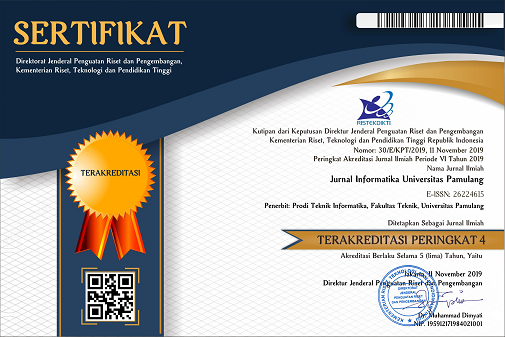Rancang Bangun Sistem Informasi Akademi: Modul Sistem Absensi Berbasis Mobile dan Web pada Universitas Universal
DOI:
https://doi.org/10.32493/informatika.v5i3.6714Keywords:
Information Systems, Attendance, QR CodeAbstract
The academic information system that focuses on the attendance module is a continuation of the manual attendance that imposes the use of attendance papers that are paraphrased by students. Attendance modules at Universal University can be designed utilizing Internet technology and network, where students only use smartphones to scan Quick-Response Code (QR Code) and web-based applications for lecturers to verify attendance. The attendance module is designed using real-time data processing. The software process Model used is the waterfall model and assisted with analysis using Unified Modelling Language (UML). The design of the application uses the PHP programming language for Web applications and Java for mobile applications, as well as databases using MySQL. The result of the design of the build attendance module in the form of a mobile application for use by students who can scan QR Code as attendance, and a Web application to be used by the lecturer as an attendance verification that has scanned QR Code and students who are not present. Attendance is more effective online when compared to manual attendance.References
Ahmar, A. (2012). Panduan Sistem Informasi Akademik Sekolah Berbasis Web (L. Hakim (ed.)). Lokomedia.
Coreit, J., Setiawan, E. B., Kurniawan, B., Studi, P., Informatika, T., Indonesia, U. K., Studi, P., Elektro, T., & Indonesia, U. K. (2015). Perancangan Sistem Absensi Kehadiran Perkuliahan dengan Menggunakan Radio Frequency Identification ( RFId ). 1(2), 44–49.
Irsan, M. (2015). Rancang Bangun Aplikasi Mobile Notifikasi Berbasis Android Untuk Mendukung Kinerja Di Instansi Pemerintahan. Jurnal Penelitian Teknik Informatika, 1(1), 115–120. http://jurnal.untan.ac.id/index.php/justin/article/view/9984/9752
Jamaliah. (2011). Sistem informasi akademik berbasis client server.
Nalintipwong, S., Tasarika, T., Ruksomya, C., Vittayakorn, S., & Numnonda, T. (2019). No Title. 2019 IEEE 9th International Conference on Electronics Information and Emergency Communication (ICEIEC), 1–5. https://doi.org/10.1109/ICEIEC.2019.8784518
Onny, A. A. R., Danur, D., Piarsa, I. N., & Sudana, A. A. K. O. (2016). Rancang Bangun Aplikasi Absensi Mahasiswa pada Platform Android. Jurnal Ilmiah Merpati (Menara Penelitian Akademika Teknologi Informasi), 4(1), 72–81.
Safaat, ?N. (2012). ANDROID?: Pemrograman Aplikasi Mobile Smartphone dan Tablet PC Berbasis Android (Edisi Revisi). Informatika Bandung.
Siregar, M., Permana, I., Sistem, J., Fakultas, I., Dan, S., Uin, T., Riau, S., Soebrantas, J. H., & Pekanbaru-Riau, P. (2016). Rancang Bangun Aplikasi Berbasis Mobile Untuk Navigasi Ke Alamat Pelanggan Tv Berbayar (Studi Kasus: Indovision Cabang Pekanbaru) 1. Jurnal Rekayasa Dan Manajemen Sistem Informasi, 2(1), 82–94. www.hostinger.co.id
Sommerville, I. (2016). Software Engineering (M. Horton (ed.); 10th ed.). Pearson Education Limited.
Sutabri, T. (2012). Analisa Sistem Informasi (2nd ed.). Andi Yogyakarta.
Tiwari, S. (2017). An introduction to QR code technology. Proceedings - 2016 15th International Conference on Information Technology, ICIT 2016, 1, 39–44. https://doi.org/10.1109/ICIT.2016.38
Zebua, T., & Pritiwanto. (2017). Pembangunan Web Mobile Absensi Mahasiswa Pada Platform Android Yang Terintegrasi Dengan Website Utama Sistem Informasi Akademik (SIA) STMIK Budi Darma. Jurnal Teknik Informatika Unika St. Thomas (JTIUST), 2(1), 100–107.
Downloads
Published
Issue
Section
License
Authors who publish with this journal agree to the following terms:
- Authors retain copyright and grant the journal right of first publication with the work simultaneously licensed under a Creative Commons Attribution-NonCommercial 4.0 International (CC BY-NC 4.0) that allows others to share the work with an acknowledgement of the work's authorship and initial publication in this journal.
- Authors are able to enter into separate, additional contractual arrangements for the non-exclusive distribution of the journal's published version of the work (e.g., post it to an institutional repository or publish it in a book), with an acknowledgement of its initial publication in this journal.
- Authors are permitted and encouraged to post their work online (e.g., in institutional repositories or on their website) prior to and during the submission process, as it can lead to productive exchanges, as well as earlier and greater citation of published work (See The Effect of Open Access).
Jurnal Informatika Universitas Pamulang have CC-BY-NC or an equivalent license as the optimal license for the publication, distribution, use, and reuse of scholarly work.
In developing strategy and setting priorities, Jurnal Informatika Universitas Pamulang recognize that free access is better than priced access, libre access is better than free access, and libre under CC-BY-NC or the equivalent is better than libre under more restrictive open licenses. We should achieve what we can when we can. We should not delay achieving free in order to achieve libre, and we should not stop with free when we can achieve libre.
Jurnal Informatika Universitas Pamulang is licensed under a Creative Commons Attribution-NonCommercial 4.0 International (CC BY-NC 4.0)
YOU ARE FREE TO:
- Share : copy and redistribute the material in any medium or format
- Adapt : remix, transform, and build upon the material for any purpose, even commercially.
- The licensor cannot revoke these freedoms as long as you follow the license terms





